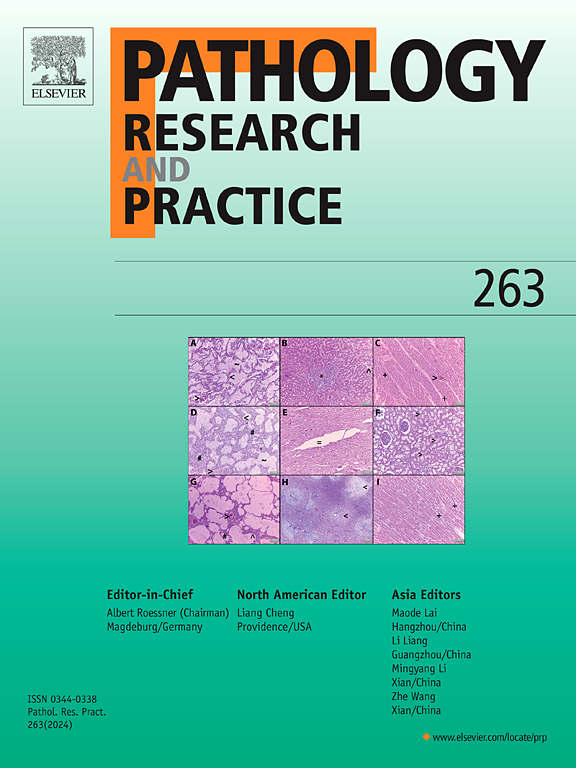Computational investigation of the interplay between cellular stress and ferroptosis in triple-negative breast cancer
IF 2.9
4区 医学
Q2 PATHOLOGY
引用次数: 0
Abstract
Recent studies have shown that ferroptosis and cellular stress are related to triple-negative breast cancer (TNBC). This study used molecular dynamics simulations (MDS) and protein-peptide docking to pinpoint the glutathione peroxidase 4 (GPX4) protein and glucose-regulated protein 78 (GRP78) interaction site. The cyclic peptide Pep42 had previously been identified as a selective target for GRP78 on cancer cell membranes. Sequence alignments reveal that the GPX4 cyclic regions: R1 (C7-C16), R2 (C16-C29), R3 (C7-C29), and R7 (C93-C102) share sequence identity of 30.00 %, 30.77 %, 38.46 %, and 42.86 % against Pep42 peptide, respectively. Moreover, these four GPX4 regions have a grand average hydrophobicity index (GRAVY) of 1.2, 1.3, 1.2, and 1.5, respectively, similar to Pep42's GRAVY of 1.1. Additionally, they show strong binding affinities for GRP78 substrate binding domain β (SBDβ) (−6.81, −7.85, −8.77, and −7.25 kcal/mol, for R1, R2, R3, and R7, respectively). This study attempts to predict the binding site which needs further extensive experimental validation aimed at exploring potential disruptors of the GRP78 –GPX4 association. This would block ferroptosis resistance and chemoresistance in TNBC.
三阴性乳腺癌细胞应激与铁下垂相互作用的计算研究
最近的研究表明,铁下垂和细胞应激与三阴性乳腺癌(TNBC)有关。本研究采用分子动力学模拟(MDS)和蛋白-肽对接技术确定谷胱甘肽过氧化物酶4 (GPX4)蛋白与葡萄糖调节蛋白78 (GRP78)相互作用位点。环状肽Pep42先前已被确定为GRP78在癌细胞膜上的选择性靶标。序列比对结果表明,GPX4环区R1 (C7-C16)、R2 (C16-C29)、R3 (C7-C29)和R7 (C93-C102)对Pep42肽的同源性分别为30.00 %、30.77 %、38.46 %和42.86 %。此外,这四个GPX4区域的大平均疏水性指数(GRAVY)分别为1.2、1.3、1.2和1.5,与Pep42的1.1相似。此外,它们对GRP78底物结合域β (SBDβ)表现出很强的结合亲和力(R1, R2, R3和R7分别为- 6.81,- 7.85,- 8.77和- 7.25 kcal/mol)。本研究试图预测结合位点,这需要进一步广泛的实验验证,旨在探索GRP78 -GPX4关联的潜在干扰物。这将阻断TNBC的铁下垂耐药和化疗耐药。
本文章由计算机程序翻译,如有差异,请以英文原文为准。
求助全文
约1分钟内获得全文
求助全文
来源期刊
CiteScore
5.00
自引率
3.60%
发文量
405
审稿时长
24 days
期刊介绍:
Pathology, Research and Practice provides accessible coverage of the most recent developments across the entire field of pathology: Reviews focus on recent progress in pathology, while Comments look at interesting current problems and at hypotheses for future developments in pathology. Original Papers present novel findings on all aspects of general, anatomic and molecular pathology. Rapid Communications inform readers on preliminary findings that may be relevant for further studies and need to be communicated quickly. Teaching Cases look at new aspects or special diagnostic problems of diseases and at case reports relevant for the pathologist''s practice.

 求助内容:
求助内容: 应助结果提醒方式:
应助结果提醒方式:


